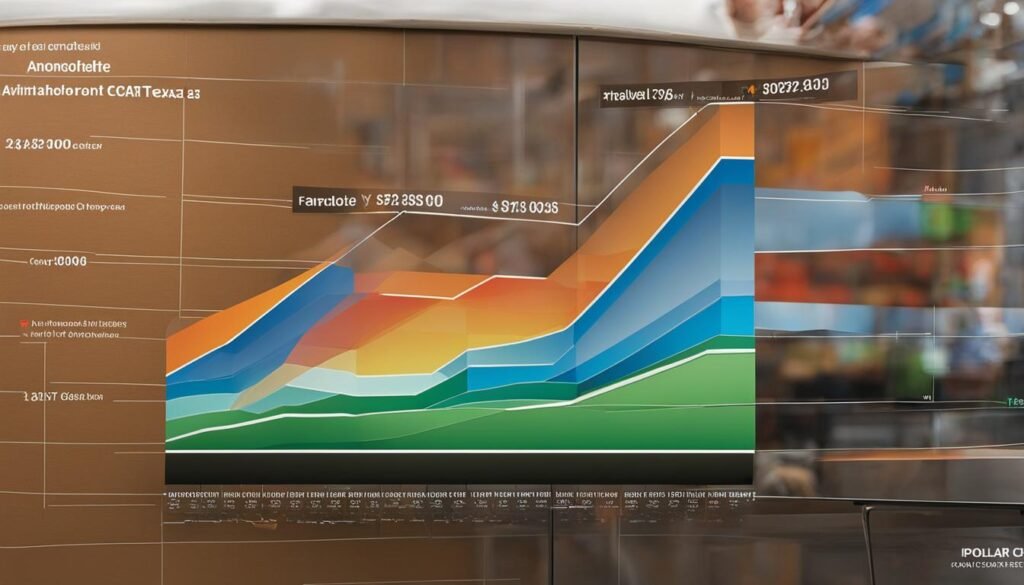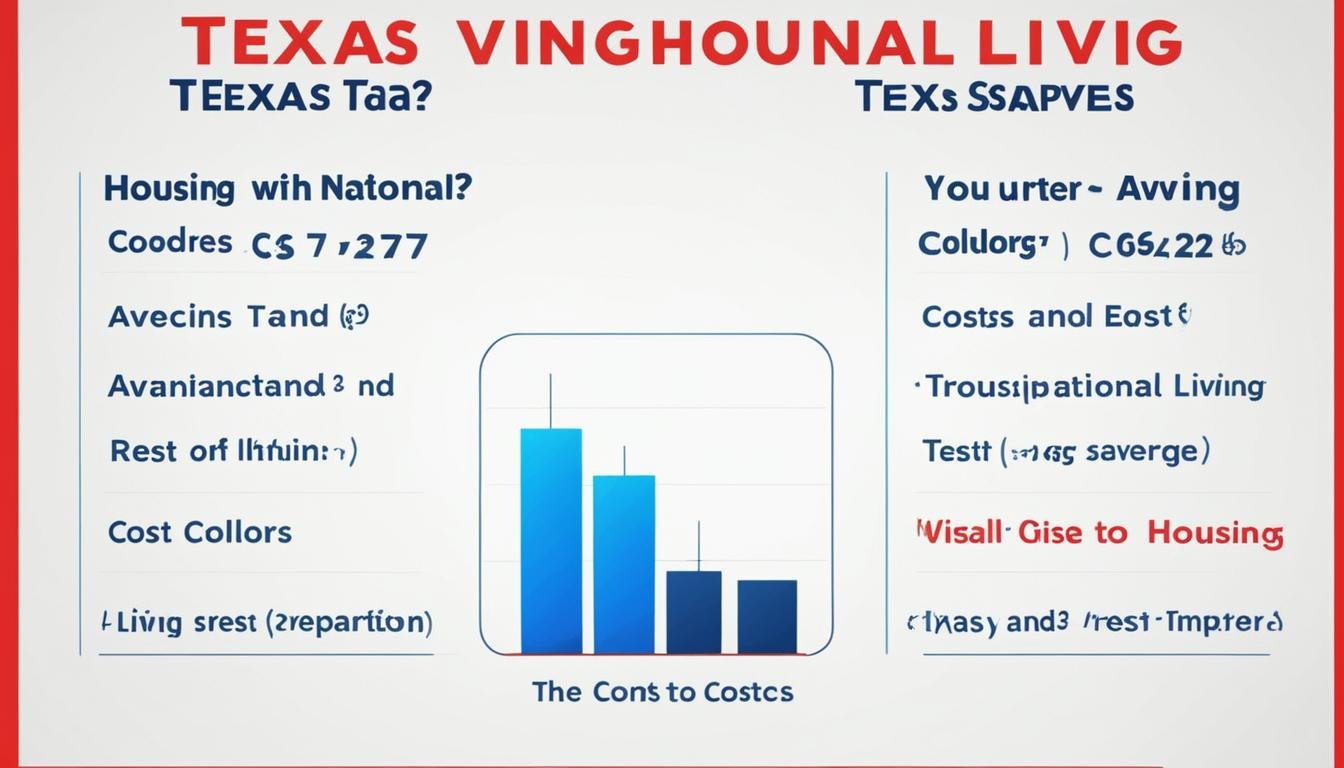Texas, known for its diverse cities and vibrant culture, also offers a unique advantage when it comes to the cost of living. In this article, we will compare the cost of living in Texas to the national average, exploring the factors that make Texas an affordable choice for residents.
When comparing the cost of living, it’s important to consider various expenses such as housing, utilities, groceries, transportation, and healthcare. Texas excels in providing lower costs in these areas, making it an attractive destination for individuals and families.
To better understand the specifics of the cost of living in Texas, we will analyze the expenses that greatly impact residents and compare them to the national average. This includes housing costs, utility expenses, grocery prices, transportation fees, and healthcare costs.
By examining these factors, individuals can gain a comprehensive understanding of the affordability of living in Texas and make informed decisions about their future.
Key Takeaways:
- Texas offers a lower cost of living compared to the national average.
- Factors such as housing, utilities, groceries, transportation, and healthcare contribute to the overall cost of living.
- Understanding the specific expenses in Texas can help individuals make informed decisions.
- Comparing cost of living using reliable data and calculators can provide a clearer perspective.
- Exploring the affordability of different Texas cities can help individuals find the best fit for their lifestyle and budget.
Understanding the Cost of Living in Texas
When it comes to cost of living, Texas offers a significant advantage over the national average. This makes it an appealing choice for individuals and families seeking affordable living expenses. In this section, we will explore the specific factors that contribute to the overall cost of living in Texas, including housing costs, utility expenses, grocery prices, transportation, and healthcare costs.
One of the key attractions of living in Texas is the lower cost of housing compared to the national average. Whether you are looking to rent or buy a home, Texas provides options that fit various budgets and lifestyles. Additionally, utility costs, including electricity and water bills, tend to be lower in Texas compared to other states.
When it comes to grocery prices, Texas offers a range of options to suit different budgets. Whether you prefer to shop at local markets or take advantage of tax-free days and discounts, there are ample opportunities to save money on your grocery expenses.
Transportation expenses in Texas also tend to be lower than the national average, thanks to lower gas prices and the availability of cost-effective transportation options. Public transportation, carpooling, and biking are some of the ways residents can reduce their transportation costs.
Healthcare costs in Texas vary depending on the city, but there are cities within the state that offer lower healthcare expenses while ensuring good healthcare availability. It’s important to consider the cost of health insurance and to focus on preventive measures to keep healthcare costs in check.
Housing Costs in Texas
Let’s take a closer look at the housing expenses in Texas. The table below provides an overview of the median home prices and average monthly rent for a two-bedroom apartment in select cities:
| City | Median Home Price | Average Monthly Rent for a Two-Bedroom Apartment |
|---|---|---|
| Houston | $250,000 | $1,200 |
| Austin | $400,000 | $1,800 |
| Dallas | $300,000 | $1,400 |
| San Antonio | $225,000 | $1,000 |
Note: The housing costs mentioned above are approximate figures and may vary.
Housing Expenses in Texas
When it comes to housing expenses, Texas offers a wide range of options to suit different budgets. The housing costs in Texas can vary greatly depending on the city you choose to live in. Let’s explore the median home prices and average monthly rent for a two-bedroom apartment in Texas.
Median Home Prices in Texas
Median home prices in Texas range from affordable to more expensive, depending on the city. Here are some examples:
| City | Median Home Price |
|---|---|
| Austin | $450,000 |
| Dallas | $350,000 |
| San Antonio | $300,000 |
Average Monthly Rent for a Two-Bedroom Apartment
Renting a two-bedroom apartment can be a more affordable option for many residents. Take a look at the average monthly rent in Texas:
| City | Average Monthly Rent |
|---|---|
| Austin | $1,800 |
| Dallas | $1,500 |
| San Antonio | $1,300 |
These figures give you a general idea of housing costs in Texas. However, it’s important to note that prices can vary based on factors such as location, property size, amenities, and local market conditions.
If you’re looking for more affordable housing options in Texas, cities like El Paso, Lubbock, and Amarillo offer lower median home prices and rental rates. These cities can provide opportunities for those seeking more budget-friendly housing.
Overall, Texas offers a range of housing options that can accommodate different financial situations. Whether you’re looking to buy or rent, there are plenty of choices available to suit your housing needs in the Lone Star State.

Utility Costs Across the State
When it comes to utility costs, Texas offers competitive rates and a deregulated energy market. This means residents have the freedom to choose their electricity providers and find the best rates that suit their needs. On average, electricity rates across the state vary depending on the provider and location, but they are generally affordable compared to national averages.
In Texas, it’s important to note that water bills also contribute to utility costs. The average water bill varies by city and usage but remains reasonable for most residents.
Moreover, Texas has been actively promoting energy efficiency initiatives to help residents lower their utility costs. Certain cities have implemented programs and incentives to encourage energy-saving practices, such as installing energy-efficient appliances, using smart thermostats, and improving insulation in homes. These initiatives not only contribute to cost savings but also promote environmental sustainability.
Sample Table – Average Electricity Rates and Water Bills in Texas Cities
| City | Average Electricity Rate (per kWh) | Average Water Bill (monthly) |
|---|---|---|
| Houston | 11.54 cents | $42.50 |
| Austin | 10.22 cents | $37.60 |
| Dallas | 12.06 cents | $45.80 |
| San Antonio | 9.98 cents | $39.20 |
Image showing energy-efficient light bulbs and the keyword “energy efficiency initiatives”.
Grocery Prices in Texas
When it comes to grocery shopping, the prices can vary depending on which city in Texas you’re in. Whether you’re looking for fresh produce, pantry staples, or specialty items, it’s important to know where to find the best deals. By being strategic with your shopping, you can save money and get the most bang for your buck.
Visiting Local Markets
One way to potentially save money on groceries in Texas is by shopping at local markets. These markets often offer a wide range of products at competitive prices. Not only can you support local farmers and businesses, but you may also find unique and high-quality items that may not be available at larger grocery stores.
Local markets can be found in many cities throughout Texas, such as the iconic Houston Farmers Market or the Dallas Farmers Market. These markets feature a variety of vendors selling everything from fresh fruits and vegetables to artisanal cheeses and homemade baked goods. By shopping at these markets, you can not only enjoy fresh, locally-sourced products but also potentially save money compared to shopping at bigger chain stores.

Take Advantage of Tax-Free Days and Discounts
If you’re looking to save even more on your grocery bill, keep an eye out for tax-free days and other discounts offered in Texas. Tax-free days are special days where certain items, including groceries, are exempt from sales tax. These days are typically announced ahead of time and can provide an excellent opportunity to stock up on non-perishable items or items that you frequently use.
In addition to tax-free days, many grocery stores in Texas offer discounts and loyalty programs. By signing up for these programs, you can receive special offers, discounts, and even earn rewards on your purchases. Some stores also have weekly or monthly sales on specific items or provide digital coupons that can be redeemed at checkout. Taking advantage of these discounts can add up to significant savings over time.
“Shopping at local markets not only allows you to support your community but also provides the opportunity to find fresh and unique products at competitive prices.”
– Amy Thompson, Local Food Advocate
When it comes to saving money on groceries in Texas, it’s all about being strategic. By visiting local markets, taking advantage of tax-free days, and searching for discounts, you can stretch your grocery budget further and enjoy delicious meals without breaking the bank.
Transportation Expenses
When considering the cost of living in Texas, transportation expenses play a significant role. Fortunately, transportation costs in Texas are generally lower than the national average, making it an attractive option for residents.
The availability of oil and the presence of the petrochemical industry contribute to the lower gas prices in the state, further reducing transportation costs. With affordable fuel prices, Texas offers a cost-effective solution for commuters and travelers alike.
To make the most of these lower transportation costs, it’s important to explore cost-effective transportation options. Here are some options to consider:
- Carpooling: Sharing rides with coworkers, friends, or neighbors not only helps minimize fuel expenses but also reduces traffic congestion and lowers carbon emissions.
- Biking: Texas has a pleasant climate and various bike-friendly routes, making it an ideal state for cycling enthusiasts. Biking not only saves money on transportation but also provides health and environmental benefits.
- Public Transportation: Utilizing public transportation, such as buses or trains, can significantly reduce transportation costs. Many cities in Texas offer reliable public transit systems, making it easier to navigate urban areas without the need for a personal vehicle.
By considering these cost-effective transportation options, residents and visitors can enjoy convenient travel while saving money on transportation expenses.
Healthcare Costs in Texas
When it comes to healthcare costs, Texas experiences significant variations across different cities. It’s crucial to consider these costs and the availability of healthcare services in order to make informed decisions. Here, we highlight cities in Texas with lower healthcare costs and accessible healthcare options. Additionally, we discuss the average cost of health insurance and the importance of preventative measures in reducing healthcare expenses.
Healthcare Costs by City
Healthcare costs in Texas can vary considerably based on the city in which you reside. While some cities may have higher healthcare expenses, there are others that offer more affordable options. For example, in Austin, healthcare costs tend to be lower compared to other metropolitan areas in Texas.
According to a study by the Texas Medical Association, the average annual healthcare expenses for an individual in Austin is approximately $6,500, whereas in Houston, it goes up to $7,200. The cost of healthcare in cities such as Dallas and San Antonio falls within this range as well, making them relatively more expensive.

| City | Average Annual Healthcare Costs |
|---|---|
| Austin | $6,500 |
| Houston | $7,200 |
| Dallas | $7,000 |
| San Antonio | $6,800 |
These figures, however, are just averages. Different factors such as the specific healthcare services required, the chosen healthcare providers, and the individual’s health insurance coverage can significantly impact the overall healthcare costs.
Healthcare Availability and Accessibility
Alongside healthcare costs, it is crucial to consider the availability and accessibility of healthcare services. In many Texas cities, such as Austin and Houston, there are numerous hospitals, clinics, and specialized medical facilities that provide comprehensive healthcare services.
It’s worth noting that rural areas in Texas may face challenges in terms of healthcare availability. Some remote regions might have limited access to healthcare facilities, which can impact both the availability and cost of healthcare services.
Health Insurance
Health insurance plays a vital role in managing healthcare costs. In Texas, the average cost of health insurance varies based on factors such as age, income, family size, and chosen plan coverage. On average, individuals can expect to pay around $400 to $600 per month for a health insurance plan in Texas.
It is important to explore different health insurance options and consider factors such as deductibles, copayments, and coverage limits to align with individual healthcare needs and financial circumstances.
The Importance of Preventative Measures
One effective way to reduce healthcare expenses is by focusing on preventative measures. By adopting a proactive approach to healthcare and prioritizing preventative care such as routine check-ups, vaccinations, and screenings, individuals can mitigate the risk of developing serious health conditions and avoid high treatment costs.
Preventative measures also include maintaining a healthy lifestyle through regular exercise, a balanced diet, and stress management. These actions can contribute to better overall health and potentially reduce the need for extensive medical treatments.
In summary, healthcare costs in Texas vary by city, with Austin generally offering more affordable options. The availability and accessibility of healthcare services across the state are important considerations. Additionally, securing appropriate health insurance coverage and prioritizing preventative measures can help individuals manage and reduce healthcare expenses.
Child Care Costs in Texas
When considering the cost of living in Texas, child care expenses play a significant role for many families. The average cost of child care in Texas can vary depending on factors such as location, age of the child, and the type of care needed.
According to recent data, the average cost of child care in Texas is approximately $875 per month per child. However, it’s important to note that this is just an average, and costs can range from as low as $500 to as high as $1,200 per month.
To further assist families with child care costs, the state of Texas offers various resources and programs. The Texas Workforce Commission provides subsidies for eligible low-income families, helping to make child care more affordable and accessible. Additionally, there are state-funded child care programs available for qualified families.
It’s important for families to explore these state resources and assess their eligibility to alleviate the financial burden of child care costs. Availability of these resources can vary based on location and income level, so it is recommended to reach out to local agencies or visit the official Texas Workforce Commission website for more details.
Child Care Costs Comparison in Texas Cities
Child care costs can vary significantly across different cities in Texas. The table below provides a comparison of the average monthly child care expenses in select cities:
| City | Average Monthly Child Care Cost |
|---|---|
| Houston | $900 |
| Austin | $1,000 |
| Dallas | $950 |
| San Antonio | $850 |
It’s important to note that these figures are approximate averages and can vary depending on the specific child care provider and the age of the child. Families should research and compare child care options in their respective cities to find the most suitable and affordable solutions.

Providing quality child care can be a significant financial commitment for many families in Texas. However, by carefully considering the available resources and exploring different child care options, families can find affordable solutions that meet their needs.
Taxes in Texas
When it comes to taxes, Texas has a unique financial landscape. Unlike many other states in the United States, Texas does not have a state income tax. This means that individuals and businesses in Texas do not need to pay a portion of their income to the state government each year. This absence of a state income tax is one of the reasons why Texas is often seen as an attractive place to live and work.
However, it’s important to note that Texas residents still have to pay other types of taxes, such as sales tax and property taxes. The sales tax in Texas varies across different cities and counties, but the average sales tax rate across the state is around 8.25%. This tax is applied to most goods and services purchased within Texas, including groceries (except for certain essential food items), clothing, electronics, and vehicles.
Property taxes in Texas are also a significant part of the state’s tax structure. Property taxes are based on the assessed value of real estate properties, including homes, commercial buildings, and land. The rates for property taxes are determined by local taxing authorities, such as counties, cities, and school districts. According to the Tax Foundation, the average effective property tax rate in Texas is 1.69%, which is slightly higher than the national average.
Texas Taxes Overview:
| Tax Type | Rate |
|---|---|
| Sales Tax | Varies by city and county, average of 8.25% |
| Property Tax | Varies by local taxing authorities, average effective rate of 1.69% |
While Texas may not have a state income tax, the presence of sales tax and property taxes is important to consider when evaluating the overall tax burden in the state. It’s advisable for individuals and businesses in Texas to consult with tax professionals or use online resources to understand their tax obligations and maximize any available deductions or exemptions.

By understanding the unique tax landscape in Texas, individuals and businesses can effectively plan their finances and make informed decisions regarding their tax obligations. While Texas offers tax advantages in certain areas, it’s essential to consider the complete financial picture and factor in all relevant taxes, such as sales tax and property taxes.
Conclusion
When comparing the cost of living in Texas to the national average, it becomes evident that Texas offers a more affordable lifestyle. With lower housing costs, utility expenses, and transportation fees, individuals can find significant savings in their day-to-day expenses. Additionally, healthcare costs in Texas are competitive, with good availability and affordable health insurance options.
By taking into account factors such as housing costs, utility costs, grocery prices, transportation expenses, healthcare costs, and taxes, individuals can confidently make informed decisions about living in Texas. Whether you’re considering relocating or looking for ways to reduce your cost of living, Texas provides a budget-friendly alternative without compromising on quality of life.
Choose Texas, and experience an affordable cost of living that allows you to stretch your dollar further, embrace new opportunities, and enjoy the diverse culture and charm the state has to offer.








